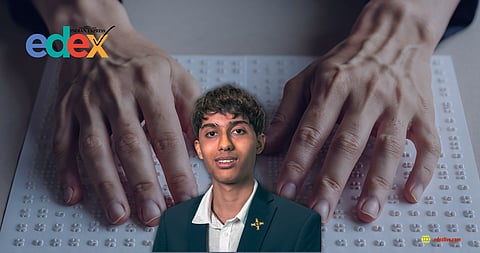

Ameya Meattle, a 17-year-old student from Singapore, began his journey to support the cause of empowering the visually impaired at a young age when he visited the Blind Relief Association over his summer vacation with his grandmother. He was moved by the spirit and resilience of the visually impaired children, which kept drawing him back each summer.
When Ameya was 14, most of his peers were focused on video games and social media. Driven by his passion to make a difference, he was focused on his goal of helping to empower the visually impaired through his social enterprise, Earth First.
From tote bags to tech
Ameya’s journey began with Earth First, a social enterprise he launched at 14 to empower visually impaired individuals. Working with eight NGOs across Singapore and India, he trained over 100 visually impaired individuals to create eco-friendly products such as tote bags, jute placemats, macrame planters, that were sold at pop-ups, bazaars, corporate orders and even retailed at stores in Singapore. The venture raised more than $12,000, with every dollar reinvested into upskilling programs.
Further, he developed and launched a Python coding curriculum for over 50 visually impaired students across multiple NGO’s, helping them transition from traditional crafts to technical careers. "Ameya has helped the visually impaired students carve new career opportunities," says Blind Relief Association, one of the partner NGOs in Delhi. "He helped our students step into the world of technology and explore exciting possibilities”. He has helped build a sustainable program that will continue long after he's gone - into a more technical and skilled ecosystem.
Making eye tests fun and accessible
Traditional eye charts are notoriously disengaging, especially for children. What about little kids or people who don’t know English letters? How do they take the test?” Ameya saw an opportunity to transform the experience entirely. Under Dr Pawan Sinha's supervision at MIT, he developed a visual reality-based diagnostic game that turns visual acuity testing into an immersive, gamified experience.
The tool has been piloted at MIT's Sinha Lab and with Project Prakash, an MIT initiative that provides cataract surgery and vision care to children in rural India. It will be used across Project Prakash sites, tracking visual improvement both before and after surgery. Young children, non-English speakers, and those with cognitive challenges often struggle with standard alphabet-based tests. Therefore, his VR game makes assessment possible for populations we've historically struggled to screen. It's not just innovative - it's necessary.
Navigating new territory
Ameya’s most recent innovation addresses another critical gap: indoor navigation. As a member of Dr Matthew Varghese's Project Canary team, he designed an audio-guided navigation device that is used as the last-mile tool to help visually impaired individuals navigate complex indoor environments like universities and hospitals. The system has already been deployed at Maitreyi College at Delhi University, St Stephens Hospital and NGO, Cure India. Dr Smriti Singh, who is an accessibility consultant at the Project Canary initiative, notes that Ameya’s contribution stands out: “That level of initiative and execution is rare at any age."
The intersection of science and compassion
With his initiatives focusing on visual impairment, Ameya has directly impacted hundreds of lives. As Ameya prepares for adulthood, he shows no signs of slowing down, with his projects continuing to scale. He looks to expand his outreach by deploying his navigation system at new locations and refining his VR acuity tool for broader clinical use. When asked about his motivation, Ameya’s answer is simple: "I believe everyone deserves a chance to see their potential”.
